 Image search results - "kora" Image search results - "kora" |

Entrance to Koishikawa Korakuen Garden. It opened as a public garden in 1938. The garden is modeled after Chinese concepts and features.Near Iiidabashi Station and Korakuen Station.
|
|

Ticket office at Koishikawa Korakuen Garden. Admission ¥300. Free English pamphlet/map available.
|
|

Map of garden. Koishikawa Korakuen Garden is designated as one of Japan's Special Historic Place and Special Scenic Spot. Only select places in Japan (like Kyoto's Kinkakuji) have both designations. 国の特別史跡・特別名勝
|
|

Weeping cherry tree
|
|

Weeping cherry tree, Koishikawa Korakuen Garden, Tokyo. 枝垂桜
|
|

This weeping cherry tree is about 60 years old.
|
|

Weeping cherry tree, Koishikawa Korakuen Garden, Tokyo.
|
|

Weeping cherry tree, Koishikawa Korakuen Garden, Tokyo. Called "Shidare-sakura" in Japanese meaning cherry tree with drooping branches.
|
|

With Tokyo Dome looming above, Koishikawa Korakuen is another famous Edo-Period Japanese garden originally built by Lord Yorifusa of the Mito Tokugawa Clan in 1629 as part of his Edo estate.The garden was completed under Lord Mitsukuni, the second lord of the Mito clan.
|
|
|
|

Shorozan hill 小廬山
|
|
|
|

Tokyo Dome in the background. The garden is right next to Tokyo Dome.
|
|
|

Larger weeping cherry tree.
|
|
|
|
|

Weeping cherry tree, Koishikawa Korakuen Garden, Tokyo.
|
|

Weeping cherries
|
|

Weeping cherry tree and Tsutenkyo Bridge 通天橋
|
|

Tsutenkyo Bridge 通天橋
|
|

Large weeping cherry tree しだれ桜
|
|
|

Folding screen (byobu) rock 屏風岩
|
|

Tsutenkyo Bridge 通天橋
|
|

View from Tsutenkyo Bridge 通天橋
|
|
|

Tokujindo Hall which stores wooden statues from old Chinese stories. 得仁堂
|
|

Koishikawa Korakuen Garden has a circular design around a pond and low hill. 回遊式庭園
|
|

Picnic area
|
|
|

Cherry trees line the Osensui pond. 大泉水
|
|

In the background is Horaijima island (not accessible). 蓬莱島
|
|

Shiraito Waterfall. Nothing spectacular. 白糸の滝
|
|

Iris bed. Should come back in June.
|
|

Colorful flowers break the monotony of greenery. ハナモモ
|
|

Ornamental peaches (Hanamomo in Japanese) ハナモモ
|
|

White ornamental peaches (Hanamomo in Japanese) look like cotton on branches. ハナモモ
|
|

White ornamental peaches ハナモモ
|
|

Eight-plank Bridge 八つ橋
|
|

Engetsukyo Bridge (Full Moon Bridge) 円月橋
|
|

Stone bridge steps 円月橋
|
|

Engetsukyo Bridge (Full Moon Bridge) so named because it creates full moon with its reflection in the water. 円月橋
|
|

Kuhachi-ya 九八屋
|
|

Naitei Inner Garden, formerly a private garden for a guesthouse built by the Mito Clan. The garden just does not match the huge Tokyo Dome in the background... 内庭
|
|

Picnickers
|
|

Outside wall of garden.
|
|

The outside wall also uses stones from the Sotobori Moat of Edo Castle.
|
|

Ohmi Railways Amago Station, Kora town's only train station. It is parallel to the shinkansen bullet train tracks on the left.
|
|

Ohmi Railways Amago Station platform. The station building (community house) can be seen ahead on the left.
|
|

The Amago Station building is called the Amago Community House. Built in Nov. 2003, it's still quite new, but looks under used.
|
|

Entering Ohmi Railways Amago Station which is also a community house.
|
|

Inside Ohmi Railways Amago Station
|
|

Ohmi Railways Amago Station front view. 尼子駅
|
|

Ohmi Railways Amago Station side view
|
|
|
|

Kora Shrine (Kora Jinja) 甲良神社
|
|
|

Kora Shrine torii. MAP
|
|

Kora Shrine
|
|

Kora Shrine
|
|
|
|

Kora Shrine Honden Hall
|
|

Kora Shrine
|
|

Kora Shrine Honden Hall
|
|
|

Kora Shrine Honden Hall
|
|

Kora Shrine's Gonden Hall is on the left of the Honden main hall. This is an Important Cultural Property. It used to be the Honden before the shrine was renovated in 1883. 権殿
|
|

Kora Shrine's Gonden Hall is believed to date from the early Edo Period.
|
|

Kora Jinja's Gonden Hall
|
|
|
|

On the right of the Honden Hall is this Kora-ishi rock. Although the triangular rock looks small above ground, it is believed to be a huge rock underground. Size unknown. They say that touching the rock brings misfortunes. So it is fenced off. 甲良石
|
|
|
|
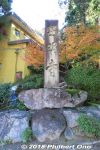
Established in 834 and located in Kora-cho town, Saimyoji is a Tendai Buddhist temple and the northern-most one in the Koto Sanzan Temple Trio. The main temple hall, designated as Japan's first National Treasure, houses statues of gods with a carving of the 12 Oriental Zodiac signs on the head. Accessible by bus from Amago Station on the Omi Railway Line.
|
|

In mid-November, a shuttle bus runs to Saimyoji and two other temples of the Koto Sanzan Temple Trio of Tendai temples. All three are famous for fall foliage.The shuttle bus starts from Hikone Station, west exit.
|
|
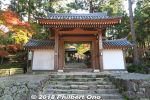
Front gate. This is where you pay the admission fee.
|
|
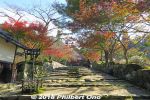
Colorful autumn path to Saimyoji Temple.
|
|
|
|
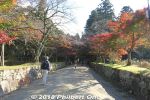
Crossing the Meishin expressway. There's a bridge over a busy and noisy expressway which you cross to get to the other side of the temple grounds.
|
|
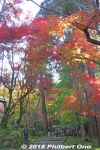
The path was a stunning showcase for autumn foilage.
|
|
|
|
|
|
|
|
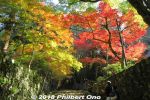
Saimyoji's autumn highlight is its stunning path to the temple.
|
|
|
|
|
|
|
|
|
|
|
|
|
|
|
|
|
|
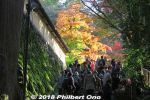
Stairs to autumn heaven. Up to here, the path was just filled with colors. And more still awaited.
|
|
|
|
|
|
|
|
|
|
|
|
|
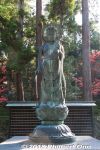
11-faced Kannon statue
|
|
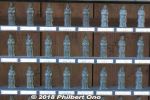
Miniature Kannon
|
|
|
|
|
|
|
|
|
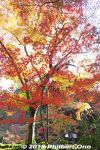
So beautiful in autumn!
|
|
|
|

Wedded cedar trees.
|
|
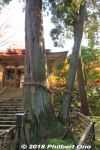
Wedded cedar trees.
|
|
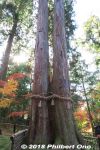
Wedded cedar trees.
|
|
|
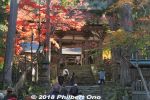
Nitenmon Gate to main temple (Hondo).
|
|
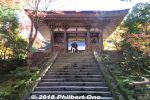
Nitenmon Gate.
|
|
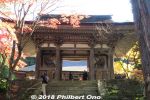
Nitenmon Gate.
|
|
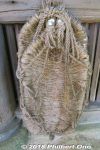
Nitenmon Gate has small waraji straw sandals. Coins stuck in the sandals.
|
|
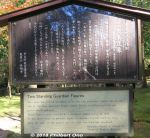
About the Niten gods guarding the gate.
|
|
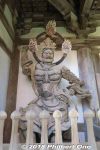
Niten god
|
|
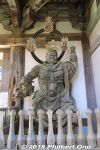
Niten god
|
|
|
|
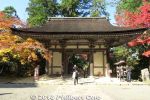
Nitenmon Gate (rear).
|
|
|
|
|
|
|
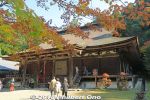
Saimyoji Temple Hondo hall (National Treasure) in Kora, Shiga. 本堂
|
|
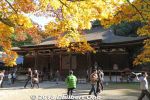
Saimyoji Temple Hondo hall (National Treasure)
|
|
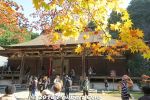
Saimyoji Temple Hondo hall (National Treasure)
|
|
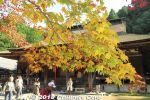
Saimyoji Temple Hondo hall (National Treasure)
|
|
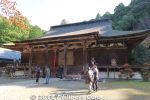
Saimyoji Temple Hondo hall (National Treasure).
|
|

Saimyoji Temple Hondo hall (National Treasure)
|
|
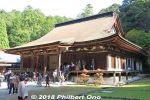
Saimyoji Temple Hondo hall (National Treasure)
|
|
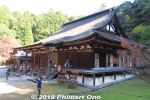
Saimyoji Temple Hondo hall (National Treasure)
|
|
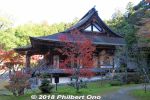
Saimyoji Temple Hondo hall (National Treasure)
|
|
|
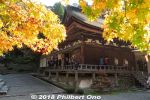
Saimyoji Temple Hondo hall (National Treasure)
|
|
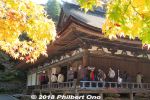
In 1571, Oda Nobunaga ordered Saimyoji to be burned down right after torching Enryakuji on Mt. Hiei. Fortunately, this Kamakura-Period main hall and the pagoda survived.
|
|
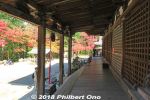
Saimyoji Temple Hondo hall (National Treasure)
|
|
|
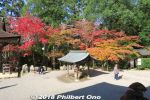
View from Saimyoji Temple Hondo hall (National Treasure).
|
|
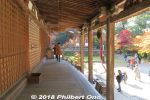
Saimyoji Temple Hondo hall (National Treasure)
|
|
|
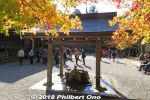
Water basin
|
|
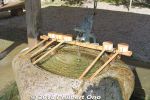
Water basin
|
|
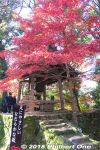
Saimyoji temple bell
|
|
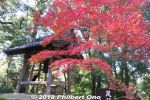
Saimyoji temple bell accented with red maples.
|
|
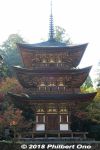
Saimyoji's three-story pagoda, a National Treasure.
|
|
|
|
|
|
|
|
|
|
|
|
|
|
|
|
|
|
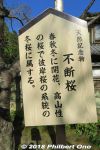
About the "ever-blooming" cherry tree (fudan-zakura).
|
|
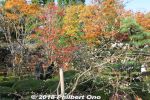
"Ever-blooming" cherry tree (fudan-zakura) planted next to a tree showing fall colors. This special cherry tree blooms in Nov. during the fall colors. 不断桜
|
|
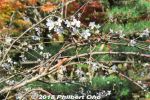
"Ever-blooming" cherry tree (fudan-zakura) in autumn.
|
|
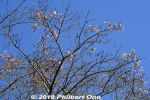
"Ever-blooming" cherry tree (fudan-zakura) in autumn.
|
|
|
|
|
|
|
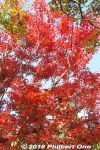
Red maple leaves.
|
|
|
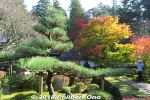
Green pine tree.
|
|
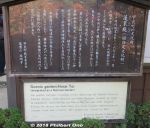
About Horai-tei Garden.
|
|
|
|

Horai-tei Garden
|
|
|
|
|
|
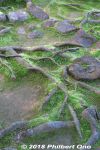
Tree roots
|
|
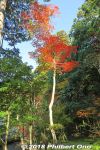
Red maples towering above.
|
|
|
|
|
|
|
|
|
|
|
|
|
|
|
|
|
|

The following photos were taken years earlier. Something things look the same, others have changed. Map of temple grounds.Established in 834 and located in Kora-cho town, Saimyoji is a Tendai Buddhist temple and the northern-most one in the Koto Sanzan Temple Trio.
The main temple hall, designated as Japan's first National Treasure, houses statues of gods with a carving of the 12 Oriental Zodiac signs on the head. Accessible by bus from Amago Station on the Omi Railway Line.
|
|

Front gate. This is where you pay the admission fee of 500 yen. During fall, the autumn leaves are brilliant, and you can enter the three-story pagoda (National Treasure) to see the wall paintings. MAP
|
|

Soon after you enter the temple, you see this "continuously blooming" cherry tree (fudan-zakura) planted next to a tree showing fall colors. This special cherry tree blooms in Nov. during the fall colors. 不断桜
|
|

Cherry blossoms which bloom in Nov. Designated as a Natural Monument and Cultural Property of Shiga. 不断桜
|
|
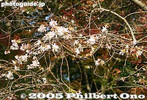
Cherry blossoms which bloom in Nov. This is full bloom. Not as glorious as the cherries in spring, but unusual to see them in Nov. 不断桜
|
|

Crossing the Meishin expressway. There's a bridge over a busy and noisy expressway which you cross to get to the other side of the temple grounds.
|
|

The path was a stunning showcase for autumn foilage.
|
|

Incredibly beautiful
|
|
|
|

Autumn leaves and stone wall
|
|
|
|
|
|
|
|

Stairs to autumn heaven. Up to here, the path was just filled with colors. And more still awaited.
|
|

At the top of the stairs
|
|
|
|

Nitenmon Gate to main temple (Hondo)
|
|

View from gate
|
|

View from gate
|
|
|
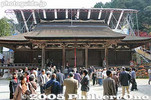
Japan's first National Treasure undergoing renovation of the roof. Saimyoji temple's Hondo hall (National Treasure) in Kora, Shiga. 本堂In 1571, Oda Nobunaga ordered Saimyoji to be burned down right after scorching Enryakuji on Mt. Hiei. Fortunately, this Kamakura-Period main hall and the pagoda survived.
|
|

Saimyoji temple Hondo Hall (National Treasure) in Kora, Shiga. In 1571, Oda Nobunaga ordered Saimyoji to be burned down right after torching Enryakuji on Mt. Hiei. Fortunately, this Kamakura-Period main hall and the pagoda survived. 本堂
|
|

Temple grounds
|
|

Inside Saimyoji temple's Hondo hall.
|
|

Hondo grounds
|
|

Hondo grounds
|
|

3-story pagoda, a National TreasureIn 1571, Oda Nobunaga ordered Saimyoji to be burned down right after scorching Enryakuji on Mt. Hiei. Fortunately, this Kamakura-Period main hall and the pagoda survived. The pagoda is 23.7 meters high.
|
|

Oda Nobunaga burned Saimyoji right after scorching Enryakuji on Mt. Hiei. Fortunately, the main hall and the pagoda survived. 3-story pagoda, a National Treasure
|
|

3-story pagoda, a National Treasure
|
|

3-story pagoda, a National Treasure
|
|

Saimyoji's 3-story pagoda, a National Treasure.
|
|

During the peak autumn season in Nov., the public is allowed to enter the pagoda to view the precious paintings on the wooden walls and pillars.
|
|

Veil of autumn leaves. Only several people can fit inside the first floor of the pagoda at one time, so you may have to wait in line.
|
|

3-story pagoda and fall colors. Photography is not allowed inside, but I highly recommend going inside. Admission 1,000 yen.
|
|

Closeup of pagoda
|
|
|
|

Temple bell
|
|

Temple bell, donate 50 yen to ring it
|
|
|

11-faced Kannon statue
|
|
|
|